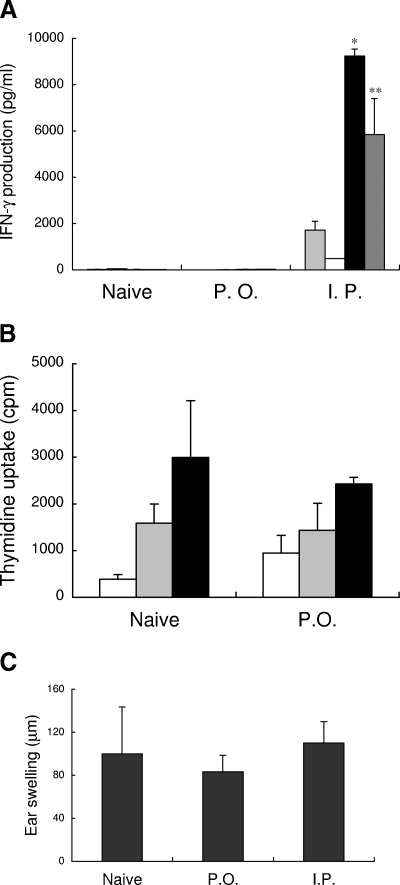FIG. 1.
HTLV-1 specificity of the T-cell unresponsiveness in orally HTLV-1-infected rats. (A) IFN-γ production in spleen T cells isolated from uninfected rats (naive) and orally (P.O.) or intraperitoneally (I.P.) HTLV-1-infected rats at 20 to 21 weeks after infection were examined by ELISA after 3 days of coculture without (░⃞) or with formalin-treated various syngeneic T-cell line cells, including G14 cells (□) negative for Tax, Tax-G14 cells (▪) expressing Tax, and FPM1 cells (▨) infected with HTLV-1. The results represent the mean ± the standard deviation (SD). Similar results were obtained in three other sets of orally or intraperitoneally HTLV-1-infected rats. Asterisks denote statistical significance compared to values without stimulator cells: ✽, P < 0.01; ✽✽, P < 0.05. (B) The alloreactivities of spleen T cells (2 × 105/well) from uninfected (Naive) and orally HTLV-1-infected (P.O.) rats at 17 weeks after infection were examined by MLRs after culture without (□) or with 5 × 104/well (░⃞) or 1 × 105/well (▪) of MMC-treated ACI rat splenocytes in a 96-well plate for 5 days and evaluated by measuring [3H]thymidine incorporation during the last 16 h of culture. (C) The contact hypersensitivity responses in the skin of uninfected (Naive) and orally (P.O.) or intraperitoneally (I.P.) HTLV-1-infected rats were evaluated at 5 weeks after infection by ear swelling for 24 h after DNFB challenge, following sensitization with DNFB in their backs 1 week previously. The ear swelling was calculated as described in Materials and Methods. The results represent the mean ± the SD for three rats in each group.

